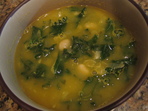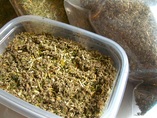Black Bean Soup

Ingredients:
- Dried Black Beans 1 lb - can use cans, 1lb, rinse in collander
- Olive oil 1/4 cup
- Bacon/ham 1/4 lb optional
- Red onions, chopped 4
- Garlic cloves, minced 4 - use less if its dried garlic
- Celery stalks w/ leaves, chopped 3
- Uncooked brown rice 1 1/2 cups (not instant)
- Cayenne pepper 1 teaspoon
- Ground cumin 2 teaspoons
- Chicken broth 3 quarts - can use vegetable or mushroom broth
- Dry white wine 1/4 cup optional
- Sherry 1/2 cup optional
- Remove split beans, debris, rinse, cover w/ water, soak overnight
- Rinse, drain, set aside beans (next day)
- Pour olive oil into lg. soup pot, add bacon/ham, onion, garlic, celery, heat at high simmer until vegetables are soft (about 30 min)
- Stir occasionally, do not cook out oil
- Add beans, rice, seasoning, broth to pot
- Bring to boil
- Reduce heat, cover, simmer 2 1/2 to 3 hours
- Let soup cool, blend until smooth, reheat in soup pot w/ sherry/wine (optional)
White Bean and Kale Soup (w/ Homemade Chicken Stock)

Ingredients:
Stock
Soup
Instructions:
To make stock:
Heat oil in lg soup pot. Add onions and salt, saute onions until soft. Add water, bay leaves, chicken, and vinegar; bring to low boil. Lower heat and simmer 20 to 45 min or longer (stock flavors deepen with time.) Taste after 30 min to see if you're satisfied or you want stock to simmer longer. Let cool. Remove chicken, strain stock into lass jars, and store in refrigerator until needed. Any meat from the cooked ckicken can be removed, sliced, and used in soups, pastas, or rice dishes. Stock will keep in refrigerator at least a week.
To make WBK soup:
Wash Kale, remove stems from leaves. Roll up leaves and cut in thin ribbons. Set aside. In a soup pot, heat olive oil and briefly saute garlic. Add about half the cooked beans and part of the stock. Puree remainder of beans and stock in blender, along with tomato pasted and sage or other herb. Stir pureed beans into soup. Add salt and pepper to taste. Mix kale into soup and simmer until kalek has wilted (10 to 15 min). Add lemon juice and enough water to give soup the desired consistency. Season to tasete. Serve topped w/ grated peocino cheese.
Stock
- 1 tbs extra-virgin olive oil
- 1 onion, chopped
- 2tsp salt (I use sea salt)
- 4 cups water
- 2 bay leaves
- 1/2 lb chicken parts w/ bones (the more chicken you use, the more nutrients)
- 1 tbs rice vinegar
Soup
- 2 cups Kale
- 1 tbs e.v.o.
- 2 lg cloves garlic
- 3 cups cooked canneloni beans (I soak mine overnight and cook separately to add later)
- 2 1/2 cups of the stock that you pre-prepared
- 1 tbs tomato paste (you can omit this if you have allergies)
- 1 tsp sea salt
- black pepper to taste
- 1 - 2 tbs fresh lemon juice
- pecorino cheese
Instructions:
To make stock:
Heat oil in lg soup pot. Add onions and salt, saute onions until soft. Add water, bay leaves, chicken, and vinegar; bring to low boil. Lower heat and simmer 20 to 45 min or longer (stock flavors deepen with time.) Taste after 30 min to see if you're satisfied or you want stock to simmer longer. Let cool. Remove chicken, strain stock into lass jars, and store in refrigerator until needed. Any meat from the cooked ckicken can be removed, sliced, and used in soups, pastas, or rice dishes. Stock will keep in refrigerator at least a week.
To make WBK soup:
Wash Kale, remove stems from leaves. Roll up leaves and cut in thin ribbons. Set aside. In a soup pot, heat olive oil and briefly saute garlic. Add about half the cooked beans and part of the stock. Puree remainder of beans and stock in blender, along with tomato pasted and sage or other herb. Stir pureed beans into soup. Add salt and pepper to taste. Mix kale into soup and simmer until kalek has wilted (10 to 15 min). Add lemon juice and enough water to give soup the desired consistency. Season to tasete. Serve topped w/ grated peocino cheese.
Healthy Pregnancy Tea

Recipe given by Aryuvedic Nutritionist
During Pregnancy:
Mix equal parts of:
Post Partum:
1 TS each of Fennel and Fenugreek, brought to a boil in 1 liter of water, then taken off heat and allowed to sit at least 15 minutes
Check http://www.holistic-herbalist.com/increase-breast-milk-production-1.html for some at home prep advice and foods.
During Pregnancy:
Mix equal parts of:
- Fennel
- Nettles
- Red Raspberry leaf
- Oatstraw
- Gotu Kola (what pregnant elephants eat)
Post Partum:
1 TS each of Fennel and Fenugreek, brought to a boil in 1 liter of water, then taken off heat and allowed to sit at least 15 minutes
Check http://www.holistic-herbalist.com/increase-breast-milk-production-1.html for some at home prep advice and foods.

 RSS Feed
RSS Feed